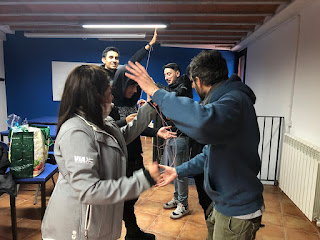The castle where Benedict lived from 1417 until his death in 1423 was restored, improved and new walls were added in 1960 when Anthony Mann's film El Cid was partially filmed there. The town and castle are now a popular tourist attraction.
After strolling through all the small streets and knowing all the magic of the town, we continue by bus to the main objective, the city of the flames that burn at night, Valencia.
We begin to know Valencia, by one of the most important sites of the city, the complex of the City of Arts and Sciences of the Valencian projected by the architect Santiago Calatrava.
We walked from street to street, in search of the best “falla”. We find small and large “fallas”, simple and complex, of all possible topics.
San José (Saint Joseph), the patron saint of carpenters, is the official focus for the festival. It all started back in the Middle Ages when carpenters used to hang up planks of wood called ‘parots’ in the winter to support their candles when they were working. At the onset of spring these pieces of wood would be burned as a way of celebrating the end of dark, winter working days. After a while they began to put clothing on the ‘parot’ and then started to try to make it identifiable with a well-known local personality. These became the forerunners of the contemporary ‘ninots’, the enormous cardboard, wooden, polyurethane, Styrofoam, cork, plaster and papier-maché figures of today. The authorities later decided to link the burning of the ‘parots’ with Saint Joseph’s Day to try to stop it getting out of control!.

 San José (Saint Joseph), the patron saint of carpenters, is the official focus for the festival. It all started back in the Middle Ages when carpenters used to hang up planks of wood called ‘parots’ in the winter to support their candles when they were working. At the onset of spring these pieces of wood would be burned as a way of celebrating the end of dark, winter working days. After a while they began to put clothing on the ‘parot’ and then started to try to make it identifiable with a well-known local personality. These became the forerunners of the contemporary ‘ninots’, the enormous cardboard, wooden, polyurethane, Styrofoam, cork, plaster and papier-maché figures of today. The authorities later decided to link the burning of the ‘parots’ with Saint Joseph’s Day to try to stop it getting out of control!
San José (Saint Joseph), the patron saint of carpenters, is the official focus for the festival. It all started back in the Middle Ages when carpenters used to hang up planks of wood called ‘parots’ in the winter to support their candles when they were working. At the onset of spring these pieces of wood would be burned as a way of celebrating the end of dark, winter working days. After a while they began to put clothing on the ‘parot’ and then started to try to make it identifiable with a well-known local personality. These became the forerunners of the contemporary ‘ninots’, the enormous cardboard, wooden, polyurethane, Styrofoam, cork, plaster and papier-maché figures of today. The authorities later decided to link the burning of the ‘parots’ with Saint Joseph’s Day to try to stop it getting out of control!
These Faults were evolving and taking on a critical and ironic sense, showing above all in the fallero monuments, scenes that reproduced censurable social facts and social criticism but always with sense of humor. Throughout the day, we went walking, eating, drinking, chatting and discovering Valencia, but when night came, the atmosphere of the city changed and suddenly, began the most awaited moment by all: THE NIGHT OF FIREWORKS. That is the moment when they do a big show of fireworks for 20 minutes. After this amazing fire scene, we went to the bus and come back to Barcelona to get a rest and have energy to start the week again !

Thanks for everybody who joined us !!!!











